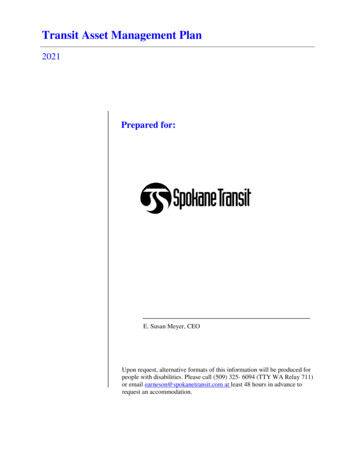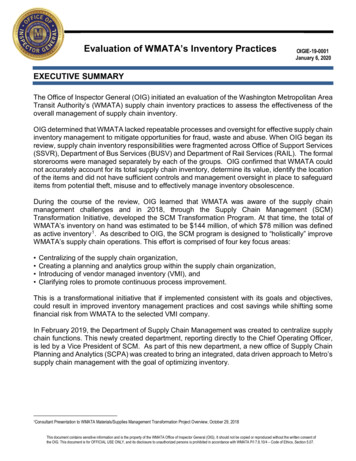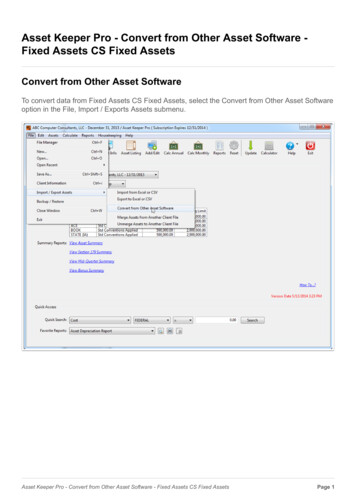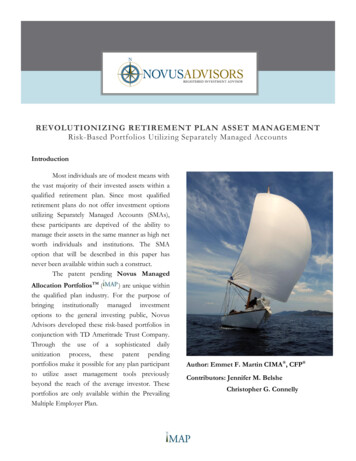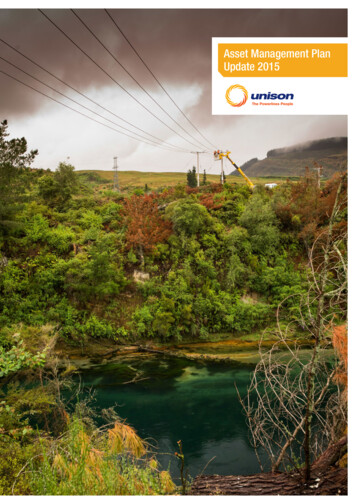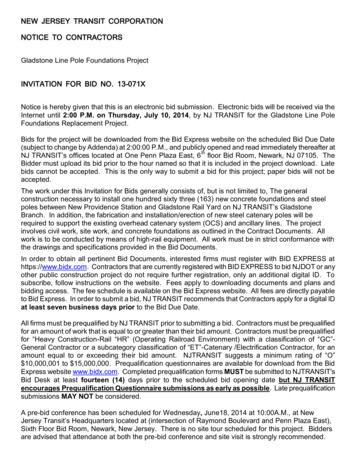
Transcription
Transit AssetManagementPlan2018 - 2022Document TitleOctober 2018W A S H I N G T O NWashington Metropolitan Area Transit AuthorityM E T R O P O L I TA NA RE AT R A N S I TA U T H O R I T Y1
Transit Asset Management PlanExecutive SummaryBackgroundThe Washington Metropolitan Area Transit Authority (Metro) operates a complex transportation systemcomprised of rail, bus, and paratransit modes. To ensure the safe and reliable provision of these services, Metroowns, operates, and maintains approximately 40 billion in transportation-related physical assets (2017) 1. Metrois implementing and improving practices to maximize the safety, reliability, and efficiency of these assets anddeliver improved service to customers, while soundly managing risks and extracting the highest valueassociated with the region’s transit assets.In 2015, the U.S. Department of Transportation found that across the nation’s transit systems, an estimated 40percent of buses and 23 percent of rail transit assets were in marginal or poor condition, largely as aconsequence of deferred maintenance and replacement. This national backlog of 90 billion of worn assets wasnoted at the time and continues to grow.2 Recognizing the importance of the performance of these assets, theFederal Transit Administration (FTA) was tasked to establish for grantees a strategic and systematic process ofoperating, maintaining and improving public transportation capital assets effectively through their entire lifecycle. The implementation of a structured asset management process – a Transit Asset Management (TAM)Plan – is one key aspect of identifiable solutions to this issue.3In July 2016, the FTA issued its Final Rule regarding TAM. This rule required grantees to: Develop a Transit Asset Management (TAM) Plan; Define State of Good Repair (SGR); Establish performance measures for SGR; and Comply with annual reporting requirements to the National Transit Database (NTD).Metro expanded upon work commenced in 2011 and implemented an agency-wide effort to develop this TAMPlan, which has been completed in accordance with the standards and timeline set by the FTA TAM Rule. Thisplan compares current TAM practices at Metro to FTA guidance and best practices and recommends a set ofasset management strategies and actions that will help ensure that the Metro system provides safe, reliable andhigh-quality service.This document consists of seven sections: this Introduction plus Sections 2 through 7, as follows: Section 1: Introduction – Provides an overview and context for Asset Management and its importance tothe industry and the Authority Section 2: Asset Management Policy – Presents Metro’s approach to asset management, includingdocumentation of asset management policy, asset management principles, and asset managementgovernance. Section 3: Asset Inventory and Conditions – Summarizes Metro’s current asset inventory as well as themethodology by which the inventory is maintained. This section also presents a snapshot of assetconditions and targets for SGR measures. Section 4: Prioritization and Reinvestment – Presents Metro’s decision support tools and process forcapital project prioritization. The section also presents Metro’s current backlog and unconstrained 10-yearcapital investment need projections. Section 5: Asset Management Baseline – Presents an evaluation of Metro’s current asset managementpractices and identifies gaps in those practices against industry asset management standards and Metro’sTAM policy.1WMATA CNI 2016, does not include land valueU.S. DOT 2015 Conditions & Performance Report3U.S. DOT 2008 Transit State of Good Repair2Washington Metropolitan Area Transit Authorityiii
Transit Asset Management Plan Section 6: Implementation Program – Describes Metro’s implementation program for asset management.This includes an action plan, an implementation timeline, a list of key annual activities, and identification ofrequired resources. Section 7: Evaluation and Continual Improvement – Details a structure for the evaluation of progressagainst the Plan to ensure continual improvement, as well as criteria and a process by which the Plan canbe revised periodically during its four-year horizon. Appendices – Glossary and information on Comprehensive Asset Management Review and Assessment(CAMRA) workshops.FTA’s Final Rule for TAM requires that the TAM Plan address nine essential elements. Table ES-1 lists anddescribes these elements with cross-references to where each of the FTA elements are addressed in Metro’sTAM Plan.Table ES-1. FTA TAM Plan RequirementsWMATA TAMTAM Plan ElementsDescriptionPlan Section1Asset InventoryA register of capital assets and information about those assetsSection 32Transit AssetConditionsAssessmentA rating of the assets' physical state; to be completed for assets anagency has direct capital responsibility for; should be at a level ofdetail sufficient to monitor and predict performance of inventoriedassetsSection 33Decision SupportToolsAnalytic processes or tools that (1) assist in capital asset investment Section 4prioritization and/or (2) estimate capital needs over time4PrioritizationA prioritized list of projects or programs to manage or improve theSGR of capital assetsSection 45TAM and SGRPolicyExecutive-level direction regarding expectations for transit assetmanagement; a TAM strategy consists of the actions that supportthe implementation of the TAM policySection 26ImplementationPlanA series of action steps for an agency to take to obtain and maintain Section 6a State of Good Repair. Addresses not only capital projects but alsoprocess and program capability improvements7List of AnnualActivitiesThe actions needed to implement a TAM Plan for each year of theplan's horizonSection 68ResourcesA summary or list of the resources that a provider needs to developand carry out the TAM PlanSection 69Monitoring,Evaluation andUpdatesAn outline of how a provider will monitor, update, and evaluate, asneeded, its TAM plan and related business practices, to ensurecontinuous improvementSection 7Sources: 49 CFR 625.25 Parts C and DWashington Metropolitan Area Transit Authorityiv
Transit Asset Management PlanSummary of Metro’s TAM Plan Recommendations and Implementation ProgramMetro’s TAM Plan summarizes and outlines how people, processes, and tools at Metro come together to supportthe Authority’s asset management effort. It provides information about both near-term tactical actions as well aslonger-term strategic initiatives that Metro will execute in order to provide actions on and visibility for integrationof asset management into decision-making and other practices regarding maintenance, capital reinvestment,service delivery, lifecycle cost management, and resilience. Additionally, it provides helpful information on howMetro will integrate and communicate asset management activities across and beyond Metro’s organization.As an umbrella document, this TAM Plan also includes as a key component a detailed TAM Policy whichsupports and aligns with the organization’s strategic plan, goals and objectives. Both recognize that assetmanagement is inherently cross-functional and empower Metro’s General Manager and Chief Executive Officerand the Executive Management Team to enable each department to implement this plan, with the Transit AssetManagement Office providing leadership and coordination.Metro’s TAM Plan includes an implementation program noting the actions needed to seize high-priorityopportunities and elevate ongoing asset management practices. The resulting list of activities, summarizedbelow and in Chapter 6, represents Metro’s commitment to improve asset management during the four-yearhorizon of this plan.This TAM Plan will enable Metro to: Improve and consolidate responsibilities, governance, and inventory information Improve opportunities for consistent and connected business processes for all asset managementpractices Improve recognition of importance of asset management roles and responsibilities Develop strategic asset management plans for all critical asset classes and improve maintenancepractices and replacement/renewals cycles Improve consistency and standard practices in considering whole life-cycle costing in asset renewalplans Improve abilities for consistently considering asset performance and condition in maintenance planning Improve the connection in processes between materials procurement and materials needs Improve opportunities for consistent use of Enterprise Asset Management (EAM) for maintenancemanagement and other asset management activities Improve the coordinated use of asset management related software applications Improve opportunities for more consistent internal communications Develop, support and reinforce a continuous improvement cultureIn accomplishing the above, Metro will focus on critical improvements in asset information to support decisionmaking and implementing improved lifecycle planning processes. Additionally, Metro will improvecommunication and training related to asset management with the aim of improving the agency’s competencyand continual improvement culture. Finally – and most importantly - Metro will establish the fundamentalbusiness processes and conditions necessary for the stewardship of a safe and reliable transit system.Washington Metropolitan Area Transit Authorityv
Transit Asset Management PlanCONTENTSFrom the General Manager. iiExecutive Summary . iii1.Introduction . 1-11.1Brief History of Metro . 1-11.2Metro’s Area of Influence . 1-21.2.1Metrorail . 1-21.2.2Metrobus . 1-31.2.3MetroAccess . 1-31.3What is Transit Asset Management? . 1-31.4Asset Management at Metro . 1-41.5The Transit Asset Management Plan . 1-51.5.1Purpose . 1-51.5.2Period Covered by the TAM Plan . 1-61.5.3Metro’s TAM Plan Contents . 1-61.5.4Relationship between This Document and FTA TAM Requirements . 1-62.Transit Asset Management Policy . 2-12.1.1Asset Management Policy Key Principles . 2-12.1.2Roles and Responsibilities . 2-22.2Metro’s 2013 Asset Management Strategy . 2-42.3Metro’s Capital Needs Inventory. 2-43.Asset Inventory and Conditions . 3-13.1Metro’s Asset Inventory . 3-13.1.1Overview of Metro’s Major Assets . 3-13.1.2Replacement Value of Metro’s Asset Inventory . 3-13.1.3Replacement Cycles of Key Assets . 3-43.1.4Asset Inventory Development and Improvement . 3-73.2Condition Assessment Methodologies. 3-83.2.1Condition Results . 3-93.2.2SGR Performance Measures and Targets . 3-104.Prioritization and Reinvestment . 4-14.1Investment Prioritization. 4-14.1.1CNI Methodology Overview . 4-14.1.2Estimating Investment Needs . 4-14.1.3Prioritizing Needs: Metro Strategic Plan (Momentum) Alignment . 4-2Prioritization Criteria. 4-2Criteria Descriptions. 4-3Special Circumstances for Prioritization . 4-3Washington Metropolitan Area Transit Authorityvi
Transit Asset Management PlanPrioritization Weights . 4-44.2Reinvestment Needs. 4-54.2.1SGR Backlog . 4-54.2.2Unconstrained Needs . 4-54.2.3Constrained Needs . 4-74.3CNI Prioritization Results . 4-85.Asset Management Baseline . 5-15.1Baseline Data Collection . 5-15.2Current Level of Maturity. 5-46.Implementation Plan . 6-76.1Implementation Approach . 6-76.2Policy, Governance and Accountability . 6-76.2.1Policy. 6-76.2.2Governance and Accountability . 6-86.2.3TAM Executive Sponsors . 6-86.3Plan Development. 6-96.3.1Asset Management Action Plan. 6-96.4Implement Action Plan . 6-146.4.1Resources Required to Implement Plan . 6-147.Evaluation and Continual Improvement . 7-17.1Communications and Change Management . 7-17.2Stakeholders . 7-27.3Performance Monitoring. 7-37.4Training . 7-57.5Future TAM Plan Revisions . 7-57.6Conclusion . 7-5AppendixesABGlossaryCAMRA WorkshopsWashington Metropolitan Area Transit Authorityvii
Transit Asset Management 4-14-25-15-26-16-2FTA TAM Plan Requirements . ivMetrorail Fixed Guideway Infrastructure . 1-3Metrorail Vertical Transportation . 1-3Benefits of Transit Asset Management for Metro . 1-4Selected Documents Related to Asset Management Practice at Metro . 1-5FTA TAM Plan Requirements . 1-7Alignment of Met
and the Executive Management Team to enable each department to implement this plan, with the Transit Asset Management Office providing leadership and coordination. Metro’s TAM Plan includes an implementation program noting the actions needed to seize high-priority opportunities and ele



